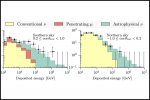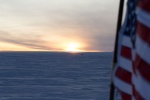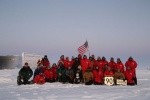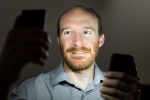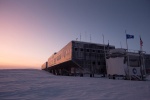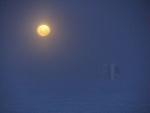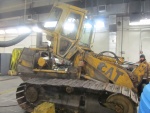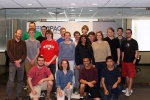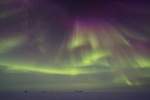Tuesday, October 7, 2014 - 8:00pm
A search for neutrino interactions inside IceCube brought evidence of an extraterrestrial neutrino flux. Now the IceCube Collaboration has expanded the search, lowering the range of deposited energy down to 1 TeV.
Tuesday, October 7, 2014 - 10:15am
Now that the sun is back at the South Pole, there’s nowhere to hide. You can walk outside and see everything—everything that was there in the darkness all winter long.
Wednesday, October 1, 2014 - 11:30am
After months and months of darkness, it’s no wonder that the sun’s return to the South Pole is anxiously awaited. So what happens when the sun finally does reappear? Lots of things.
Wednesday, October 1, 2014 - 11:00am
Justin Vandenbroucke, a University of Wisconsin-Madison assistant professor of physics and researcher at the Wisconsin IceCube Particle Astrophysics Center (WIPAC), leads the development of an app that can turn your cell phone into a cosmic ray detector.
Thursday, September 25, 2014 - 2:30pm
As dawn approaches, the sky is cast in a glow that reflects off the sides of the South Pole station. Inside the station, they’ve begun to remove the window covers that remain in place all winter, there to minimize light pollution for sensitive experiments at the Pole.
Tuesday, September 16, 2014 - 12:30pm
There’s the moon, but where’s the sun? It’s coming, it’s coming. At the South Pole, the sun rises only once a year (and it sets only once a year, too).
Tuesday, September 9, 2014 - 1:45pm
As with any week at the Pole, activities involved a mix of work and play. First and foremost last week, voting results were announced from this year’s Winter Antarctic Film Festival.
Tuesday, September 9, 2014 - 1:00pm
Professor Kael Hanson has just been appointed as director of WIPAC and director of IceCube maintenance and operations, as well as professor of physics at the University of Wisconsin−Madison.
Thursday, September 4, 2014 - 11:45am
“The high school internship at WIPAC was easily one of the highlights of my senior year. It was an amazing experience getting to talk to and work one-on-one with grad students,” says former WIPAC intern Collin Buelo. “I would highly recommend the program to any high school student thinking about going into any area of physics.”
Wednesday, September 3, 2014 - 9:00am
If you’ve seen one, you’ve seen them all. Not so for auroras. These spellbinding light shows come in various patterns, shapes, and colors.

